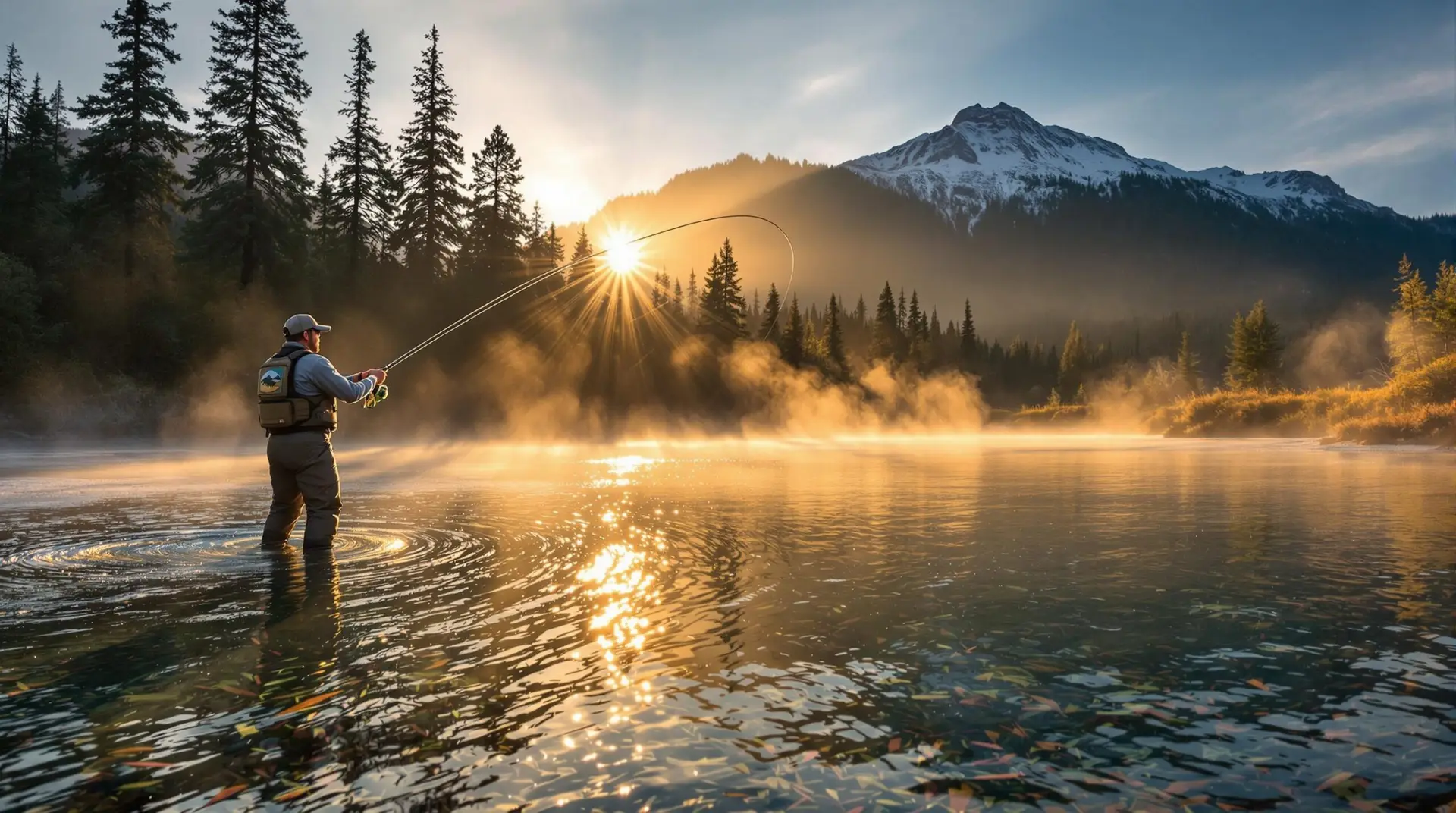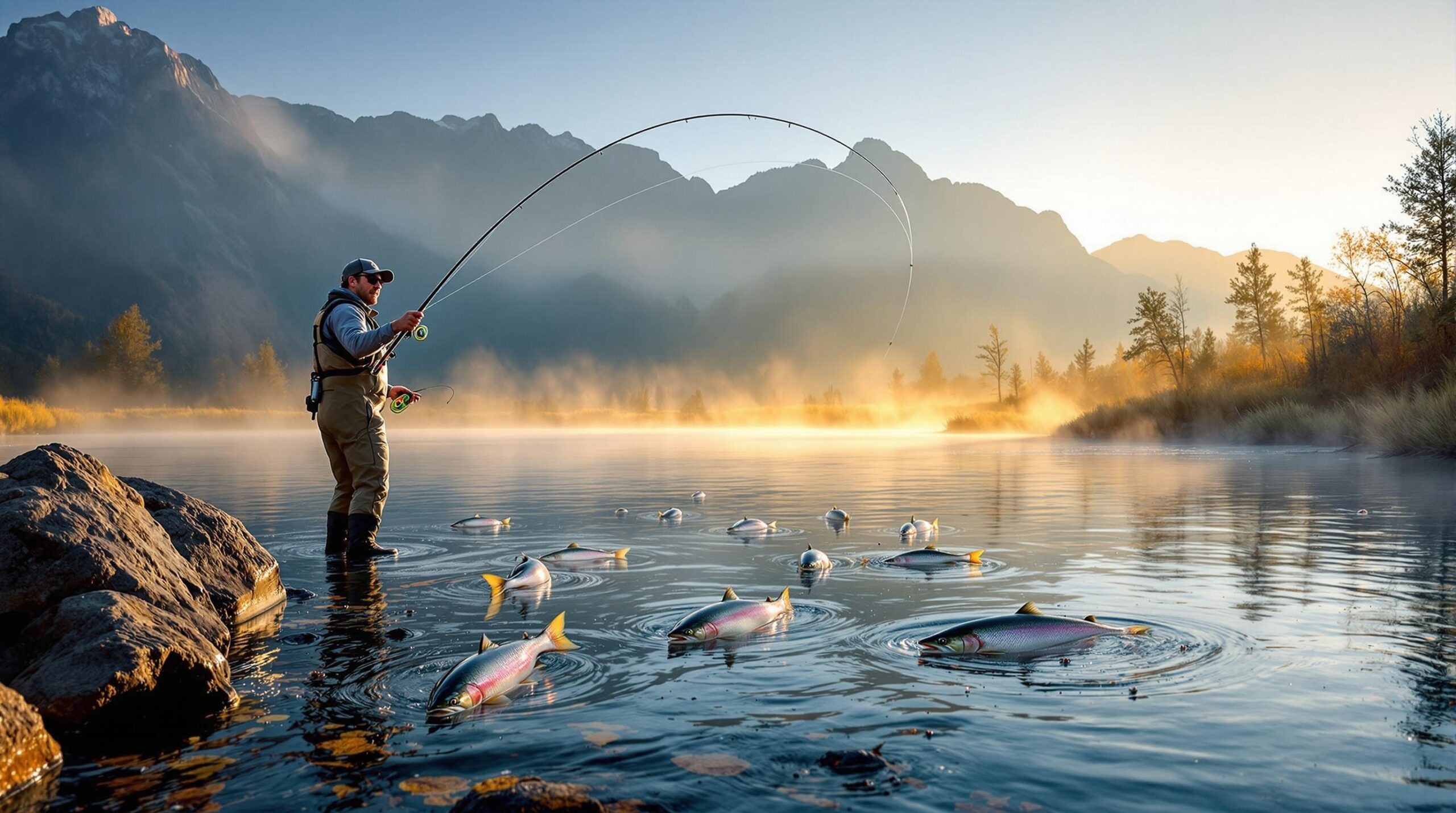According to a study by the Oregon Department of Fish and Wildlife, fly fishing in Oregon contributes over $346 million annually to the state’s economy while supporting thousands of jobs across guides, tackle shops, and hospitality sectors—all while offering some of North America’s most diverse angling opportunities. Oregon’s pristine rivers, mountain lakes, and coastal streams provide year-round fly fishing adventures for anglers of all skill levels, from legendary steelhead runs on coastal rivers to native trout in high alpine waters, making fly fishing in Oregon a must-experience activity for serious anglers.
Key Takeaways
- The Deschutes River stands as Oregon’s premier fly fishing destination, famous for its salmonfly hatch and steelhead runs
- Oregon offers year-round fly fishing opportunities across diverse waterways including coastal streams, mountain lakes, and tailwaters
- Proper gear selection and understanding seasonal hatches significantly increases success rates on Oregon waters
- Conservation practices are essential when fly fishing in Oregon to preserve native fish populations
- Oregon fishing regulations require specific licenses and may include special rules for catch-and-release or fly-fishing-only sections
The Legendary Deschutes River: Oregon’s Premier Fly Fishing Destination
The Deschutes River stands as the crown jewel for fly fishing in Oregon. This 252-mile waterway flows through central Oregon, offering some of the most productive trout and steelhead fishing in the Pacific Northwest. Renowned fly fishing destinations like the Deschutes attract anglers from across the globe, particularly during the famous salmonfly hatch.
According to economic impact reports, the Deschutes and similar Oregon rivers generate millions in revenue for local economies. The lower 100 miles of the river provide exceptional opportunities for catching native redband rainbow trout, which typically average 12-16 inches but frequently reach 20+ inches. The river’s consistent flows and insect hatches make it productive nearly year-round for fly fishing in Oregon.
For steelhead enthusiasts, the late summer through fall offers prime opportunities to target these magnificent sea-run rainbow trout. The annual steelhead migration brings thousands of fish into the system, with the best fishing typically occurring from August through October. Experienced anglers recommend swinging traditional steelhead patterns like the Skunk or Purple Peril on sections between Warm Springs and Maupin.
Year-Round Trout Action on the Crooked River
The Crooked River presents one of the most consistent opportunities for fly fishing in Oregon throughout all seasons. This tailwater fishery below Bowman Dam maintains stable water temperatures year-round, creating ideal conditions for trout feeding even during winter months when many other Oregon waters slow down significantly.
Research from local fly fishing outfitters indicates winter midge hatches on the Crooked River can produce success rates exceeding 70% when using small zebra midge patterns in sizes #18-22. The river’s proximity to Bend (just 45 minutes away) makes it one of the most accessible quality fisheries for fly fishing in Oregon.
The Oregon Department of Fish and Wildlife stocks between 60,000-100,000 rainbow trout fingerlings annually in the Crooked River, supplementing the wild redband population. This management approach creates opportunities for anglers to experience 15-25 fish days in the prime 8-mile tailwater section below the dam. Current regulations require barbless hooks and implement a 5 trout daily limit with an 8-14 inch slot limit to protect breeding-sized fish.
Coastal Steelhead Opportunities for Fly Fishing in Oregon
Oregon’s coastal rivers offer some of the most thrilling steelhead fishing in North America. Rivers like the Wilson, Trask, and Siletz see annual returns of 2,000-4,000 winter steelhead, with fish averaging 28-34 inches and frequently exceeding 10 pounds. These chrome-bright ocean-fresh fish provide incredible fights and represent the ultimate prize for many anglers fly fishing in Oregon.
Spey casting techniques dominate the coastal steelhead scene, allowing anglers to effectively cover wide rivers with minimal backcast room. According to FishingBooker’s comprehensive guide, the most productive patterns include larger intruder-style flies in purple, black, and blue during higher water conditions, switching to smaller presentations as rivers clear.
Oregon’s 34 coastal hatcheries release approximately 1.2 million steelhead smolts annually, creating a sustainable fishery while protecting wild stocks. For those new to coastal steelhead fishing, guided trips ($550-750 for full-day floats) provide access to private stretches with significantly higher fish-per-mile ratios than public access points. These guides have intimate knowledge of tide cycles, which can dramatically affect hookup rates for fly fishing in Oregon’s coastal systems.
Fly Fishing in Oregon’s McKenzie River System
The McKenzie River represents one of Oregon’s most beautiful and productive trout fisheries. This crystal-clear spring-fed river maintains consistent water temperatures and flows year-round, creating ideal habitat for wild rainbow trout. The upper reaches near Clear Lake offer exceptional sight fishing opportunities, where anglers can spot trout holding in current seams.
The McKenzie’s robust hatches provide excellent dry fly fishing throughout the season. Research from Perfect Fly Store indicates March-April Grannom Caddis emergers (sizes #14-16) trigger aggressive surface feeding activity. During July and August, terrestrial patterns account for approximately 60% of successful bankside catches, with grasshopper imitations being particularly effective.
Conservation remains a priority on the McKenzie, where proper catch-and-release practices help reduce mortality rates below 20%. Anglers fly fishing in Oregon’s McKenzie should use barbless hooks and rubber mesh nets to minimize stress on fish. The river’s easy access from Eugene makes it an excellent destination for both half-day and full-day fishing adventures.
High Lakes Fly Fishing in Oregon’s Cascade Mountains
Oregon’s Cascade Mountains contain hundreds of alpine lakes offering unique fly fishing experiences. Paulina Lake, with depths exceeding 250 feet, creates ideal habitat for trophy brown trout reaching 28 inches. Effective techniques here include trolling Woolly Buggers on sinking lines at 15-25 feet depth, with average catch rates of 5-8 quality fish per day for experienced anglers.
For those seeking a more intimate experience, Elk Lake’s fly-only brook trout fishery provides exceptional opportunities for fly fishing in Oregon’s high country. Special regulations protect the 14-18 inch brook trout population, creating a sustainable trophy fishery. During October, Callibaetis mayfly hatches trigger surface feeding activity that can be effectively targeted with #16 Parachute Adams patterns.
Access to many high Cascade lakes requires a Northwest Forest Pass ($30 annual), and some of the most productive lakes involve short hikes that limit fishing pressure. The season for these alpine gems typically runs from late May through October, with July and August offering the most consistent action for fly fishing in Oregon’s mountain lakes.
Essential Gear and Regulations for Fly Fishing in Oregon
Successful fly fishing in Oregon requires proper gear selection based on target species and fishing location. For trout streams, a 9′ 5-weight rod provides versatile performance, while steelhead pursuits demand heavier 10′ 7-weight setups. According to DIY Fly Fishing’s Oregon guide, the most productive fly patterns include:
- Yak Caddis (#12-16): 80% success rate during McKenzie River caddis hatches
- Possie Bugger Nymph (#8): Accounts for 45% of Deschutes River trout catches
- Egg-Sucking Leech (black/purple): 25% steelhead hookup ratio on coastal systems
- Parachute Adams (#14-18): Effective on nearly all Oregon trout waters
Understanding Oregon’s fishing regulations is essential for legal and ethical fly fishing in Oregon. License costs include $44 for annual resident permits, $106 for non-residents, plus a Combined Angling Tag ($46) required for salmon and steelhead. The Fly Shop Northwest recommends purchasing licenses online before your trip to avoid delays.
Conservation considerations include proper identification of wild versus hatchery fish (approximately 90% of coastal steelhead are hatchery-origin with clipped adipose fins). Most Oregon rivers implement strict “Pack It In, Pack It Out” policies, and careful fish handling significantly improves survival rates for catch-and-release fishing.
Frequently Asked Questions
What is the best time of year for fly fishing in Oregon?
Oregon offers year-round fly fishing opportunities, but the prime seasons depend on your target species. For trout, late spring through early fall (May-September) provides the most consistent action with major hatches. Steelhead fishing peaks during summer/fall (July-October) on the Deschutes and winter (December-March) on coastal systems. For the most diverse opportunities, June through September offers excellent conditions across most Oregon waters.
Do I need a guide for fly fishing in Oregon?
While not required, a guide can significantly enhance your experience, especially for first-time visitors or when targeting steelhead. Guides provide access to productive water, offer specialized equipment, and share techniques refined through years of experience. For beginners, even a single guided day can accelerate your learning curve dramatically. Self-guided anglers should research access points thoroughly and consider purchasing detailed river maps.
What flies work best for fly fishing in Oregon?
Essential flies for Oregon waters include: Pheasant Tail Nymphs (#14-18), Elk Hair Caddis (#12-16), Stimulator (#10-14), Woolly Bugger (olive/black #6-10), and Copper John (#16-18). For steelhead, bring Intruder patterns and traditional wet flies like the Green Butt Skunk. Always check with local fly shops for specific recommendations based on current conditions and hatches.
Where can beginners go fly fishing in Oregon?
The Crooked River below Bowman Dam offers excellent beginner-friendly fly fishing with easy wading, consistent flows, and plentiful trout. The Fall River near Sunriver provides similar advantages with crystal-clear water for sight fishing. Lakes like Hosmer and East Lake offer forgiving conditions where beginners can practice casting without worrying about complex currents or limited backcast room.
What fishing license do I need for fly fishing in Oregon?
Oregon requires an annual fishing license ($44 resident/$106 non-resident) or a 1/3/7-day temporary license for visitors. When targeting salmon, steelhead, or sturgeon, you’ll also need a Combined Angling Tag ($46). Some waters require additional endorsements or permits. Licenses can be purchased online through the Oregon Department of Fish and Wildlife website or at sporting goods stores throughout the state.
Are there any fly fishing only waters in Oregon?
Yes, Oregon maintains several fly fishing only waters, including sections of the Metolius River, North Fork Umpqua, Deschutes River (parts of the middle section), Fall River, and specific regulations on certain lakes like Crane Prairie Reservoir. These waters typically prohibit any fishing with bait and sometimes restrict anglers to using artificial flies with single barbless hooks. Always check current regulations as these designations can change annually.
Sources:
DIY Guide to the Best Fly Fishing in Oregon
Guided Fly Fishing Trips in Oregon & Washington
Crooked River – The Fly Fishers Place
Local Waters – Central Oregon Fly Fishing Destinations
Economic Contribution & Value of Hatcheries in Oregon & Washington
How to Go Fly Fishing in Oregon: The Complete Guide for 2025
Fly Fishing Report On The McKenzie River In Oregon
Fishing Industry Economic Activity Trends – Lincoln County, OR
Regional Economic Impacts of Recreation on the Wild and Scenic Rogue


